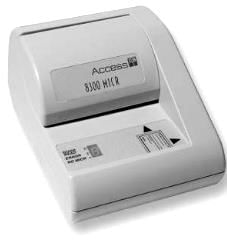Bank Exams Exam > Bank Exams Questions > ___________ is a type of input device that is...
Start Learning for Free
___________ is a type of input device that is used in bank for cheques Processing.
- a)Joystick
- b)Penball
- c)Scanner
- d)MICR
- e)Bar code Reader
Correct answer is option 'D'. Can you explain this answer?
Most Upvoted Answer
___________ is a type of input device that is used in bank for cheques...
Understanding MICR in Cheque Processing
MICR, or Magnetic Ink Character Recognition, is a specialized technology used primarily in the banking sector for cheque processing. It plays a crucial role in streamlining and automating the handling of cheques.
What is MICR?
- MICR uses magnetic ink to print characters on cheques, typically at the bottom.
- The characters include bank codes, account numbers, and cheque numbers, which are essential for processing.
Importance of MICR in Banking
- Speed and Efficiency: MICR technology allows for rapid reading of cheque information, significantly speeding up the processing time.
- Accuracy: The use of magnetic ink minimizes errors associated with manual data entry, ensuring accurate transaction processing.
- Security: MICR provides a level of security as the magnetic ink is difficult to forge, reducing the risk of cheque fraud.
How MICR Works
1. Reading Process: Cheques are fed through a MICR reader, which detects the magnetic ink characters using magnetic sensors.
2. Data Extraction: The reader converts the magnetic information into digital data that can be processed by banking systems.
3. Processing: Once the data is extracted, it is used for further processing, such as clearing and settlement of funds.
Conclusion
In summary, MICR is an essential input device in banks for cheque processing, providing speed, accuracy, and security. Its ability to automate the reading of cheque information makes it a vital tool in modern banking operations.
MICR, or Magnetic Ink Character Recognition, is a specialized technology used primarily in the banking sector for cheque processing. It plays a crucial role in streamlining and automating the handling of cheques.
What is MICR?
- MICR uses magnetic ink to print characters on cheques, typically at the bottom.
- The characters include bank codes, account numbers, and cheque numbers, which are essential for processing.
Importance of MICR in Banking
- Speed and Efficiency: MICR technology allows for rapid reading of cheque information, significantly speeding up the processing time.
- Accuracy: The use of magnetic ink minimizes errors associated with manual data entry, ensuring accurate transaction processing.
- Security: MICR provides a level of security as the magnetic ink is difficult to forge, reducing the risk of cheque fraud.
How MICR Works
1. Reading Process: Cheques are fed through a MICR reader, which detects the magnetic ink characters using magnetic sensors.
2. Data Extraction: The reader converts the magnetic information into digital data that can be processed by banking systems.
3. Processing: Once the data is extracted, it is used for further processing, such as clearing and settlement of funds.
Conclusion
In summary, MICR is an essential input device in banks for cheque processing, providing speed, accuracy, and security. Its ability to automate the reading of cheque information makes it a vital tool in modern banking operations.
Free Test
FREE
| Start Free Test |
Community Answer
___________ is a type of input device that is used in bank for cheques...
Important Points
- MICR stands for Magnetic Ink Card Reader.
- MICR input device is generally used in banks.
- In banks, there are a large number of Cheques need to Processed daily.
- On cheques, the bank code number and cheque number have been printed.
- And the ink through which it is Prints is a special type of ink containing magnetic particles.
- MICR is used to read that ink.


|
Explore Courses for Bank Exams exam
|

|
Question Description
___________ is a type of input device that is used in bank for cheques Processing.a)Joystickb)Penballc)Scannerd)MICRe)Bar code ReaderCorrect answer is option 'D'. Can you explain this answer? for Bank Exams 2025 is part of Bank Exams preparation. The Question and answers have been prepared according to the Bank Exams exam syllabus. Information about ___________ is a type of input device that is used in bank for cheques Processing.a)Joystickb)Penballc)Scannerd)MICRe)Bar code ReaderCorrect answer is option 'D'. Can you explain this answer? covers all topics & solutions for Bank Exams 2025 Exam. Find important definitions, questions, meanings, examples, exercises and tests below for ___________ is a type of input device that is used in bank for cheques Processing.a)Joystickb)Penballc)Scannerd)MICRe)Bar code ReaderCorrect answer is option 'D'. Can you explain this answer?.
___________ is a type of input device that is used in bank for cheques Processing.a)Joystickb)Penballc)Scannerd)MICRe)Bar code ReaderCorrect answer is option 'D'. Can you explain this answer? for Bank Exams 2025 is part of Bank Exams preparation. The Question and answers have been prepared according to the Bank Exams exam syllabus. Information about ___________ is a type of input device that is used in bank for cheques Processing.a)Joystickb)Penballc)Scannerd)MICRe)Bar code ReaderCorrect answer is option 'D'. Can you explain this answer? covers all topics & solutions for Bank Exams 2025 Exam. Find important definitions, questions, meanings, examples, exercises and tests below for ___________ is a type of input device that is used in bank for cheques Processing.a)Joystickb)Penballc)Scannerd)MICRe)Bar code ReaderCorrect answer is option 'D'. Can you explain this answer?.
Solutions for ___________ is a type of input device that is used in bank for cheques Processing.a)Joystickb)Penballc)Scannerd)MICRe)Bar code ReaderCorrect answer is option 'D'. Can you explain this answer? in English & in Hindi are available as part of our courses for Bank Exams.
Download more important topics, notes, lectures and mock test series for Bank Exams Exam by signing up for free.
Here you can find the meaning of ___________ is a type of input device that is used in bank for cheques Processing.a)Joystickb)Penballc)Scannerd)MICRe)Bar code ReaderCorrect answer is option 'D'. Can you explain this answer? defined & explained in the simplest way possible. Besides giving the explanation of
___________ is a type of input device that is used in bank for cheques Processing.a)Joystickb)Penballc)Scannerd)MICRe)Bar code ReaderCorrect answer is option 'D'. Can you explain this answer?, a detailed solution for ___________ is a type of input device that is used in bank for cheques Processing.a)Joystickb)Penballc)Scannerd)MICRe)Bar code ReaderCorrect answer is option 'D'. Can you explain this answer? has been provided alongside types of ___________ is a type of input device that is used in bank for cheques Processing.a)Joystickb)Penballc)Scannerd)MICRe)Bar code ReaderCorrect answer is option 'D'. Can you explain this answer? theory, EduRev gives you an
ample number of questions to practice ___________ is a type of input device that is used in bank for cheques Processing.a)Joystickb)Penballc)Scannerd)MICRe)Bar code ReaderCorrect answer is option 'D'. Can you explain this answer? tests, examples and also practice Bank Exams tests.

|
Explore Courses for Bank Exams exam
|

|
Signup for Free!
Signup to see your scores go up within 7 days! Learn & Practice with 1000+ FREE Notes, Videos & Tests.


















